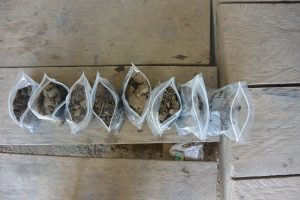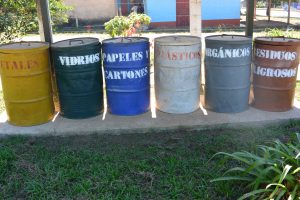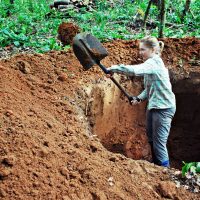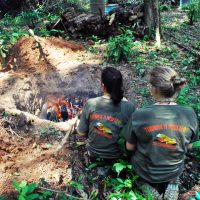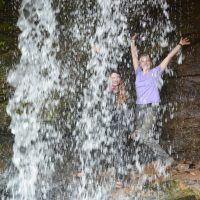Connecting the dots: From Bainbridge Island to Peru
Danielle Bogardus takes on independent research in Peru with a goal to divert waste and contribute to healthy forests and communities.
Riding on ponies as a child shaped Danielle Bogardus’s experience with nature. Her mother was a horse trainer, and being around horses was a typical part of her day.
“I have never known anything but nature. It’s been in my backyard for as long as I can remember, and that’s where I center myself,” shares Danielle.
Danielle applied to UW to be an Environmental Studies major, citing as her impetus the disconnect between the scientific world and the communities being affected by environmental issues. Merging arts, humanities and sciences was a way for her to bridge this divide between science and society.
Why I study the environment
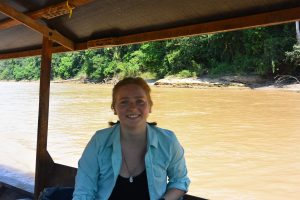
Danielle grew up on Bainbridge Island, in Washington. She knew she wanted to pursue education related to the environment but it wasn’t until her brother suggested that she speak with her TA from ENVIR 100 (Introduction to Environmental Studies), incidentally his good friend, that she discovered her niche.
This friend was Samantha Zwicker, also an Environmental Studies alumna, and current PhD student at the School of Environment and Forest Sciences at UW. Zwicker had started a non-profit called Hoja Nueva, focusing on permaculture practices in Madre de Dios, Peru. The mission of the organization is finding balance between agriculture, the environment and people’s prosperity.
Hooked by this conversation with Zwicker in her freshman year, Danielle began conducting research for Hoja Nueva in Peru, around waste management, and in particular on compost.
Why composting? “My mother focuses on composting horse manure at a large scale so I was exposed to that earlier on and realized there’s always a way to find value in waste!”
In communities in Peru however, the larger problem is what to do with items that aren’t biodegradable. Danielle modified her research, and took on helping with marketing and communicating with the community to find ways to handle the waste on hand and eventually divert waste from the waste stream.
In Winter 2015, Danielle secured an independent research project through the School of Environment and Forest Sciences as part of the Vogt lab, with Kristina Vogt’s mentorship, and Program on the Environment faculty member Tim Billo as her advisor.
Navigating a different culture, dedicating to a cause
The goal for that first trip was to immerse herself completely into a new culture, explore the area and understand it, and build relationships in the community. Hiking through the jungle was one way to know the environment and see how ecosystem services work. It was an incredibly humbling experience.
Language was a challenge; Danielle knows intermediate Spanish. She spent a week in Cusco taking one-on-one Spanish lessons. Each trip strengthens her ability to converse with the community.
For Danielle, it was critical to see the juxtaposition of preservation and destruction in Peru. She learned that “China (had) recently built a railroad through the last pristine area of rainforest in the region of Peru where I traveled. I have never been exposed to devastation at that scale, and the rate of it – to notice barren orange land from extreme mining amidst swaths of trees – that’s something else.”
What was your biggest memory?
“Walking through Hoja Nueva’s protected land of 90 hectares was a pivotal moment. The land was so vibrant, so dense. The land just encapsulates you, it is so alive and so biodiverse.”
“And then suddenly we came to the border of this land, to 10 hectares of adjacent deforested land. It was so eery – silent and devoid of life. A sad moment.”
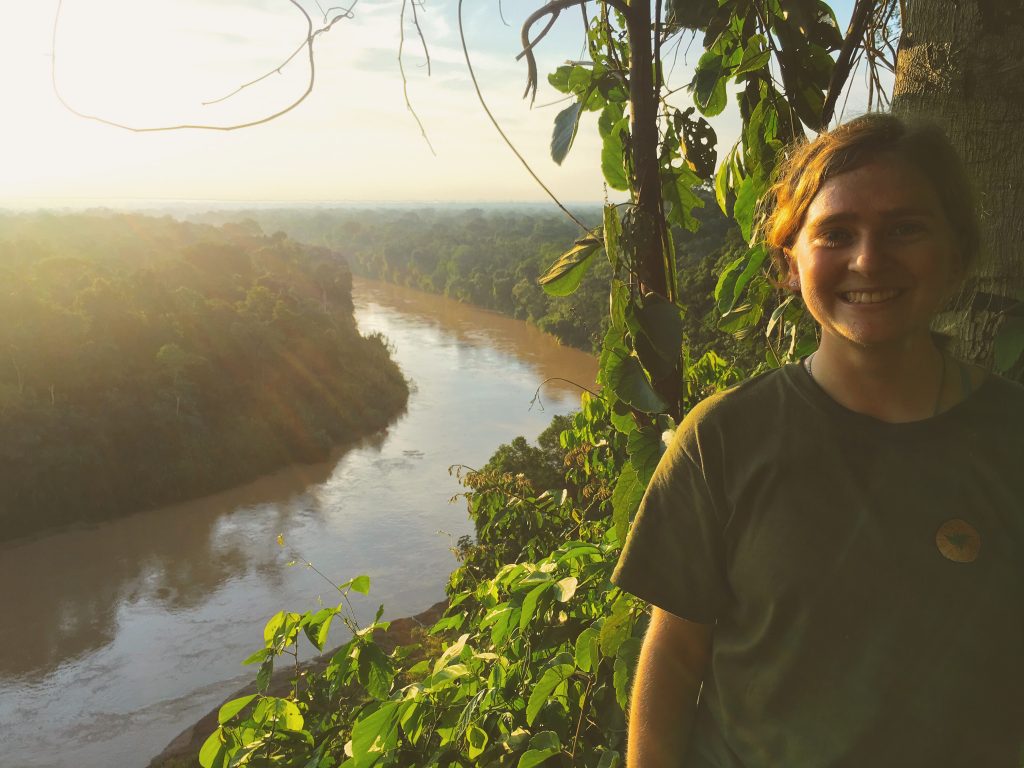
This experience provided inspiration to see what can be done if land is protected, and how she can make a positive impact. She is a firm believer that the solution lies in seeing not just the beauty, but also the devastation.
Piloting a waste management plan
Danielle returned to Peru to conduct a case study in Lucerna, a town of 65 people, with a goal to create a practical management plan. The plan focuses on handling the waste the residents accumulate, broken up into organics and non-organics, recyclables, chemical waste (hygiene), and mechanical fluids.
New challenges have emerged: the influx of goods due to increased development and China’s railroad plans resulting in new roads being built to access remote towns. Increased access to packaged food increases packaging waste. There are limited means to dispose of this waste; much is buried, burned or thrown into the river.
“In talking to some members of the community, I found they don’t understand why waste is bad….out of sight is out of mind (as is the case for some back home too).”
For Danielle, a point of leverage is to demonstrate how waste is directly affecting the residents’ lives. This means conducting soil, water and pig feces sampling and conveying the detrimental impacts to human health.
- Soil samples taken from Lucerna.
- An example of waste separation in the nearby town of Pianchon.
Danielle and Hoja Nueva have received support from the Mayor of Puerto Maldonado, the nearest city in the Madre de Dios region, and the community commissioner of Lucerna. Danielle has permission to use the government lab facilities in the city to conduct her water sampling, for free.
She conducted daily waste audits, and followed three families (one of whom she stayed with) for a week to observe how much waste they accumulated. The residents welcomed Danielle, in part due to her introduction into the community on her first visit.
“The problem is that there is nowhere for this waste to go,” sighs Danielle. The landfill in Puerto Maldonado is at capacity and Danielle has been advised to reach out to share her data with the private sector or NGO’s to make the case for increased support. Her primary goals are to incentivize the community (e.g. receiving money to collect recycling), raise funds for sustainable disposal, explore different uses for waste and increase education about waste and health.
- Danielle digging a biochar pit
- Burning biochar.
- Rejoicing in a waterfall upriver.
From Danielle’s perspective, the need is dire. “We can tackle this, one community at a time. I see the opportunity that is there. And I feel invested in the community, for whom living sustainably should be a natural right but is simply not accessible right now. I see that maybe all it takes is one more person to really attack the problem and facilitate the necessary steps towards communication with the government.” Her inspiration is the children in the communities, and their future.
Danielle intends to weave her research project into her Environmental Studies capstone. The end goal would be to establish a practical, sustainable waste management system in Lucerna.
“My work won’t be done until then. This might have to grow into a graduate level project. Whatever it takes.”
Funding to fuel big dreams
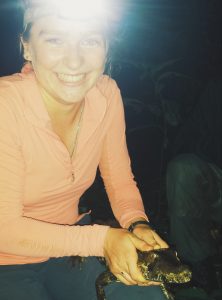
Last year, Danielle applied for and was awarded a forestry alumni scholarship from the School of Environment and Forest Sciences, which helped pay for tuition. Her first trip to Peru was funded through crowdsourcing donations from friends and family.
Earlier this year, Danielle received the environmental studies leadership scholarship, which she again put towards her tuition. As she embarks on her third trip to Peru this Winter, she needs additional funding through her CrowdRise campaign to help quantify the daily volume of waste she collects in Peru and seek the private funding necessary to dispose of waste in Lucerna.
If you feel compelled, Danielle welcomes your support. “As I’ve found since I had that first conversation with Samantha and asked to be a part of Hoja Nueva, the worst thing people can say to you is no, so why not ask for help or that opportunity.”
